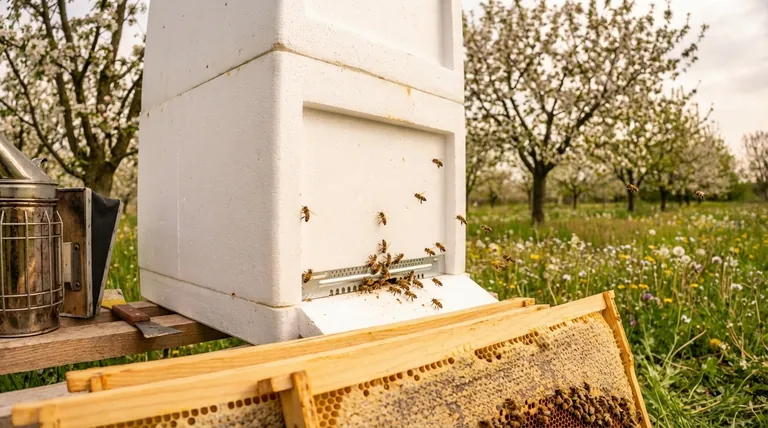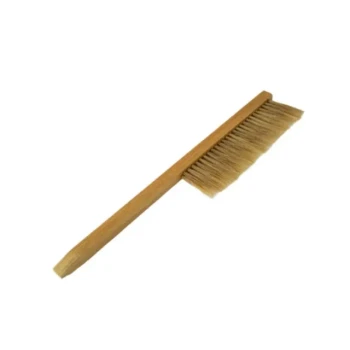For beekeepers focused on reproduction and breeding, styrofoam hives provide two primary advantages over traditional wood. Their superior insulation allows colonies to build up population numbers earlier in the spring, and it enables the queen to use more of the available frame space for laying eggs. This combination results in stronger colonies, faster, and extends the effective season for creating new splits, nucs, and queens.
The core principle is thermal efficiency. By drastically reducing the energy a colony must expend to maintain its critical brood nest temperature, styrofoam hives free up the colony's resources to be redirected into what matters most for reproduction: raising more bees, earlier and faster.

The Core Advantage: Superior Thermal Insulation
A honeybee colony's primary energy expense, after foraging, is thermoregulation. The brood nest, where new bees are raised, must be kept at a stable 93-96°F (34-36°C). The material of the hive directly impacts the colony's ability to do this efficiently.
Maintaining Brood Nest Temperature
In a wooden hive, the walls have poor insulating value. This means in cooler weather, the outer frames become too cold to raise brood, forcing the colony to expend significant energy just to keep the central core warm.
How Styrofoam Changes the Equation
High-density polystyrene (styrofoam) has a much higher insulation value than wood. It acts like a thermos, minimizing heat loss in the cold and buffering against extreme heat in the summer.
This thermal stability means the temperature is consistent across all the frames in the brood box. The colony uses far less energy—and consumes fewer honey stores—to maintain the ideal temperature.
A Healthier, Drier Environment
The superior insulation also prevents condensation, a common problem in wooden hives during winter. A damp, cold hive increases stress and the risk of diseases like Nosema. Styrofoam hives create a warmer, drier environment, leading to better overwintering success and a healthier, more robust population ready for spring reproduction.
Translating Insulation into Reproductive Success
A healthier colony with more energy directly translates into tangible breeding advantages for the beekeeper. The benefits of thermal efficiency compound quickly once the season begins.
An Earlier Start to the Season
Because the hive interior remains warmer, the queen can begin her intensive egg-laying earlier in the spring. A colony in a styrofoam hive can start building its population weeks before a colony in a wooden hive in the same apiary.
Maximizing Brood Space
In a wooden hive, the queen is often reluctant to lay on the outermost frames, as they are too cold. This creates a "chimney" effect where the brood is concentrated in the center.
In a styrofoam hive, the queen will lay eggs from "wall to wall." This full utilization of every frame dramatically increases the sheer volume of brood a colony can raise, leading to explosive population growth.
A Longer Window for Nucs and Splits
These two factors—an earlier start and a larger brood area—result in a powerful colony much sooner in the year. This gives the beekeeper a significantly longer season to make splits (dividing one strong colony into two) and raise new queens. For any operation focused on increasing colony count, this extended window is a critical operational and financial advantage.
Understanding the Trade-offs
While effective for reproduction, styrofoam hives are not without their disadvantages. Objectivity requires acknowledging their limitations compared to traditional wood.
Durability and Handling
Styrofoam is less durable than wood. It can be damaged by hive tools, dropped equipment, or pests like wax moths and rodents if not properly maintained. They require more careful handling.
Management Adjustments
The excellent insulation that is so beneficial in the cold can become a liability in extreme heat if not managed. Styrofoam hives require adequate ventilation and sometimes more diligent monitoring to prevent overheating in hot climates.
Weight and Portability
The light weight of styrofoam is a significant advantage, reducing physical strain and fuel costs for transport. For commercial beekeepers moving hundreds of colonies for pollination, this is a major factor.
Making the Right Choice for Your Breeding Goals
The choice between wood and styrofoam depends entirely on your primary objective as a beekeeper. Both are viable tools, but they excel in different areas.
- If your primary focus is maximizing the number of nucs and splits: Styrofoam's ability to accelerate spring buildup and expand the brood nest offers a clear and decisive advantage.
- If your primary focus is operating in a region with cold winters or cool, damp springs: The thermal and moisture-wicking properties of styrofoam dramatically improve overwintering survival and the speed of the subsequent buildup.
- If your primary focus is long-term durability and a "traditional" feel: Wood remains the standard for its longevity and resilience to rough handling, even if it means a slower start for the colonies inside.
Ultimately, leveraging hive technology to match your specific reproductive goals is a hallmark of strategic beekeeping.
Summary Table:
| Advantage | Impact on Reproduction & Breeding |
|---|---|
| Superior Insulation | Earlier spring buildup; queen starts laying weeks sooner. |
| Wall-to-Wall Brood Nest | Maximizes frame usage; dramatically increases brood volume. |
| Warmer, Drier Environment | Improves overwintering success; leads to healthier, robust colonies. |
| Extended Breeding Window | Longer, more productive season for creating splits, nucs, and queens. |
Ready to Boost Your Apiary's Reproductive Output?
For commercial apiaries and beekeeping equipment distributors, the strategic advantage of styrofoam hives is clear: stronger colonies, faster. By enabling earlier spring buildup and maximizing brood production, you can significantly increase your nuc and queen production capacity.
HONESTBEE supplies the high-quality, wholesale-focused beekeeping equipment you need to achieve these results. Let us help you leverage hive technology to meet your specific breeding goals.
Contact HONESTBEE today to discuss how our styrofoam beehives can transform your operation's productivity and profitability.
Visual Guide

Related Products
- Professional Grade Foldable Beehive Handles
- Professional Galvanized Hive Strap with Secure Locking Buckle for Beekeeping
- Mesh Ventilated 3 Layer Goatskin Beekeepers Gloves for Beekeeping
- HONESTBEE Durable Frame Wiring Board with Integrated Tensioner
- Langstroth Screen Bottom Board for Beekeeping Wholesale
People Also Ask
- Why are regular hive checks important for Flow Hives? It's About Bee Health, Not Just Honey
- How does a beekeeper's demeanor affect the bees? Cultivate Calm for a Safer, More Productive Hive
- What equipment is needed to start beekeeping? Your Essential Guide to a Successful Apiary
- How can beekeepers remember the timeline of bee development from egg to pupa? Use the 3-6-12 Rule.
- When should the first inspection of a new hive be conducted? Ensure a Strong Start for Your Colony



















